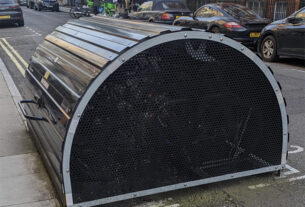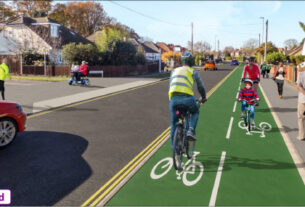 Cllr Paul Gittings recently took over from Cllr Adele Barnett-Ward as the Chair for the SEPT (Strategic Environment, Planning and Transport) Committee.
Cllr Paul Gittings recently took over from Cllr Adele Barnett-Ward as the Chair for the SEPT (Strategic Environment, Planning and Transport) Committee.
Paul kindly provided answers to a few questions we put to him on transport matters:
RCC: Doing things quickly is always a challenge for local government given procedures that need to be followed. Reading has a net zero carbon target by 2030, which is only nine years away. What changes do you expect to see in transport in Reading in the next three years?
PG: This is indeed an ambitious target, although I’m confident the Council and its estate and other public sector organisations will meet it, having made good progress over the course of the last decade and more since being one of the first signatories of the Nottingham Declaration.
Regarding the next three years, or indeed the next nine, it’s very difficult to make predictions, not least because of the implications of a global pandemic which is likely to cast its shadow for some time yet.
As we have seen, I expect a significant shift to methods of sustainable transport such as cycling and walking and hope the habits formed by people during lockdown continue.
The size of that shift is largely dependent on factors outside of the immediate control of the Council, probable changes in working practices, more done from home, less commuting and by implication a reduction of peak traffic flows and congestion, which is surely a good thing.
The government has provided limited funding, with strings attached, for temporary and permanent schemes that encourage, in the main, cycling by putting in better infrastructure, and we are about to consult on Tranche 2 which will cover some of the main arterial routes into and within Reading.
I would hope that with the near £1.2million provided, we can implement at least one of these schemes and hold the others in readiness for future funding, if they can command sufficient levels of public support.
These will be in tandem with other measures in the local Transport Plan, not least the extensive work being done on the A33 corridor and the coming on stream of Green Park station.
More difficult to predict will be the impact of the pandemic on our award-winning bus company, but I would expect in three years for passenger numbers to return to pre-pandemic levels and probably increase as part of a modal shift which has always been inherent in the Council’s planning.
Leaving aside the move to EV, which still does not tackle congestion and road safety, the biggest part citizens can play in tackling climate change is to reduce their own emissions through less use of their motor cars. And I hope the Council can encourage this through the transport plan and other related measures.
RCC: What do you think is the biggest blocker to more uptake of cycling and what changes would you most like to see to improve cycling in Reading?
PG: I think it is clear that concerns over safety act as a blocker and it’s no coincidence that during the first Lockdown, when the roads were largely deserted, we saw more people out and about on bikes.
However, I think that’s only part of the problem, as over the past 50 years and more we have developed a car-dominated culture in Britain, compare and contrast to the Netherlands and Denmark, and a built environment and infrastructure based on that premise.
If you look at the major arterial routes into Reading and the IDR in particular, this is self-evident and there are real challenges involved in unravelling that historic planning and design in favour of cycling, but not impossible.
So, for every town like Reading, and we are not uncommon, we need a better segregated (and non-segregated) cycling infrastructure. This comes at a very big price and must be almost entirely funded by the government and other bodies such as the Local Enterprise Partnership plus planning gain.
We also need locally and nationally to really press home the public health message about the benefits of cycling. I think the BMA produced statistics that the risks to health of not being active (by cycling) outweighed the risk from fatality in an accident by 20 to 1 and that is telling.
The Council is actively working on or considering other measures, School Streets being a prime example, Lower Traffic Neighbourhoods, which would also improve the general conditions and uptake of cycling.
RCC: How do you see the Cycle Forum contributing to the Council’s future vision for Reading?
PG: The Cycle Forum is important because, see my comments above, cycling can play a really big role in meeting our targets for carbon emissions in the light of the Council declaring a Climate Emergency in 2019.
It’s also a forum where we can have an open and transparent exchange of views on these issues.
It is now being scheduled in tandem with the Cleaner Air and Safer Transport Forum (CAST) which was introduced by my predecessor as SEPT Chair Cllr Adele Barnett-Ward, which is designed to look at the broader sustainable transport issues and I think this is a good mix.
RCC: The Local Transport Plan that was issued for consultation talked about demand management – what form do you think that should take?
PG: The LTP does indeed offer up a variety of these measures, some such as Workplace Parking Levy, have already been successfully implemented in other towns and cities. I would like to see measures that limit polluting and Heavy Goods Vehicles from using Reading as a ‘cut through’, because this is an ongoing problem and air quality in parts of the town needs to improve, although there has been some temporary ‘relief’ during the pandemic.
From a purely personal point of view, I am strongly in favour of macro measures such as road pricing which charges per mile driven, based on where you are driving, what time you are driving and what you are driving.
Realistically, this requires action by national government to implement such schemes in consultation with local authorities. Only by this type of demand management do I believe we can make real progress to net zero in the future, but is there the political will to take these steps?
RCC: What would your advice be for engaging with Ward Councillors on transport issues?
PG: Keep engaging! I can’t speak for opposition Councillors, but my Labour colleagues are always keen to hear your views and are able through bodies such as the Traffic Management Panel to make representations and support road safety and transport schemes in their ward.
RCC: You are a keen West Reading cyclist – (a) which roads do you try to avoid (b) where would you go for a leisure cycle?
PG: I can honestly say that I make no conscious effort to avoid any road as I believe with the correct positioning and general aptitude it’s perfectly safe to ride on all our roads in Reading and the general area.
If I’m pushed, I would say that on the A33 relief road dual carriageway I would prefer to use the segregated path alongside it, but if out ‘training’ and riding more briskly I use the main carriageway.
For a leisure ride, within the borough boundaries, I go with my younger son along the Thames footpath, using Christchurch Bridge and the Horseshoe Bridge depending on the route. These routes are not just great for leisure rides, but also offer great alternatives for commuters going West-East and vice-versa.



